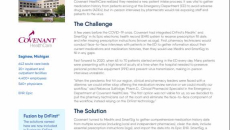Electronic Health Records (EHR, EMR)
Also, Bangkok Dusit Medical Services has partnered with Samsung Medison for medical imaging and AI.
From EHR optimization to AI-enabled CDS, big advancements are happening with biomedical informatics. Chris Harle, researcher at Regenstrief Institute and professor at Indiana University, discusses data science, provider experience, patient safety and more.
The electronic health record vendor group was founded two decades ago with a bold premise: competitors working collaboratively to identify issues related to software development and functionality for EHRs and to further the initiatives laid out by HHS.
Its telehealth technology will use the Suki artificial intelligence platform to generate clinical notes to help reduce documentation burden.
Join leaders from Scripps and Monument Health as they talk with DrFirst’s CMO, Colin Banas, M.D., M.H.A., about their real-world uses of AI-powered solutions to help clinicians save time and enhance care delivery.
Cone Health is one of the largest health networks in North Carolina, with more than 100 locations. Pharmacists often had to make multiple phone calls to confirm a patient's medication list, then manually enter the information into their Epic electronic health record (EHR) system, increasing the likelihood of human error, and the potential for adverse drug events and clinician burnout.
Face-to-face medication history interviews during the patient intake process in Covenant HealthCare’s emergency department (ED) were eliminated at the start of the pandemic in 2020.
The electronic health record giant says that it did not violate federal law prohibiting unfair business practices when it raised concerns about certain patient data requests over the Carequality interoperability framework.
Also, the Australian Department of Health and Aged Care is looking for a chief digital information officer.
Also, athenahealth intros athenaOne for Behavioral Health, and Clarify Health empowers payers with AI-driven cost containment tools and quality improvement analytics.






